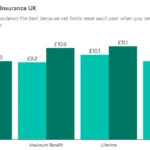Table of Contents
ToggleDog insurance for pre existing conditions UK –
Dog insurance can provide pet owners peace of mind and financial protection if their dog becomes ill or injured. However, for dogs with pre-existing conditions, obtaining coverage can be challenging. A pre-existing condition is any health condition that your dog has been diagnosed with or shown symptoms of before the start date of your insurance policy. These conditions can range from chronic illnesses like diabetes or arthritis to more acute conditions like ear infections or allergies. In this article, we’ll discuss how dog insurance companies in the UK handle pre-existing conditions and what pet owners can do if their dog is denied coverage due to a pre-existing condition.
What are pre-existing conditions in dog insurance?
In dog insurance, pre-existing conditions refer to any health condition that your dog has been diagnosed with or shown symptoms of before the start date of your insurance policy. It can be any condition, whether a chronic illness like diabetes, heart disease, or cancer, or an acute condition like ear infections, allergies, or a broken bone.
Pet insurance providers consider pre-existing conditions a significant factor when determining the coverage they can provide your dog. Insurance companies do not cover pre-existing conditions because it is an existing medical issue that your dog had before the start of your insurance policy.
To illustrate, suppose your dog has been diagnosed with diabetes before you enrolled them in a pet insurance policy. In that case, the insurance company will consider diabetes a pre-existing condition. It will not cover any costs associated with treating diabetes or its resulting conditions.
It’s essential to note that once a condition is considered pre-existing, it is unlikely to be covered by any pet insurance company in the future, even if the condition is unrelated to the previous diagnosis. Therefore, it is vital to understand how pet insurance companies define and identify pre-existing conditions.
Some pet insurance companies may define pre-existing conditions differently from others. It’s essential to check the policy’s terms and conditions before you sign up and ensure that you understand how the provider defines pre-existing conditions. Most policies exclude pre-existing conditions from their coverage.
It’s also worth noting that some pet insurance providers may offer coverage for pre-existing conditions after a specific waiting period. However, this is uncommon, and the waiting period can be lengthy.
How do dog insurance companies define pre-existing conditions?
Regarding dog insurance, pre-existing conditions refer to any health condition or symptom that your dog has had before the start of their insurance coverage. These conditions can range from minor issues like allergies to more severe issues like chronic illnesses or injuries.
Dog insurance companies define pre-existing conditions differently depending on the company and the policy. Some companies may have a broad definition that includes any condition your dog has shown symptoms for or received treatment for, even if the condition was never officially diagnosed. Other companies may have a narrower definition that only includes conditions officially diagnosed by a veterinarian or requiring ongoing treatment.
In general, pre-existing conditions are not covered under most dog insurance policies. This is because insurance companies are designed to protect against unexpected future events, not to cover pre-existing conditions that may require ongoing or costly treatment.
It’s important to note that some insurance companies may offer coverage for pre-existing conditions, but it may come with restrictions or higher premiums. It’s crucial to read the policy carefully and understand what is and is not covered before purchasing dog insurance.
Insurance companies may also consider the dog’s age when defining pre-existing conditions. Older dogs are more likely to have pre-existing conditions, and some companies may have different definitions for conditions that occur in older dogs versus younger dogs.
How do dog insurance companies identify pre-existing conditions?
Regarding dog insurance, pre-existing conditions can greatly impact coverage options and premiums. As a result, dog insurance companies have specific methods for identifying and determining pre-existing conditions.
The first step in identifying pre-existing conditions is usually a medical history review. Dog insurance companies will often ask for a complete medical history of the pet, including any previous diagnoses, surgeries, or treatments. They may also request access to medical records of earlier veterinarians.
In addition to reviewing medical history, many dog insurance companies also require a mandatory waiting period before coverage for certain conditions can begin. During this waiting period, any pre-existing conditions that are identified will not be covered. This waiting period varies between companies but is typically between 14 and 30 days.
Dog insurance companies may also require a physical examination of the pet before providing coverage. This examination may be conducted by a licensed veterinarian approved by the insurance company. The veterinarian will thoroughly examine the pet to identify any pre-existing conditions, including signs of illness or injury.
Another method that dog insurance companies may use to identify pre-existing conditions is through breed-specific exclusions. Certain dog breeds are more prone to certain health conditions, and insurance companies may exclude coverage for these conditions in specific breeds.
Lastly, dog insurance companies may also have a policy of not covering certain pre-existing conditions altogether. These conditions may be deemed too costly to cover or may be considered too high risk to insure.
How do dog insurance companies use medical records to determine pre-existing conditions?
Dog insurance companies use various methods to determine if a dog has pre-existing conditions. One of the most common ways is by reviewing the dog’s medical records. This includes previous treatments, medications, surgeries, and any ongoing health conditions. To access these records, the insurance company will usually require the owner to provide consent and release forms to authorize the release of the records.
Once the medical records have been obtained, the insurance company’s underwriters will review them carefully. They will look for any evidence of pre-existing conditions, which may include chronic illnesses, injuries, or other health issues that were diagnosed or treated before the start of the insurance policy. If the underwriters find evidence of pre-existing conditions, they will typically exclude coverage for those conditions from the policy.
In some cases, the insurance company may also require the dog to undergo a medical exam before coverage can be approved. During this exam, a veterinarian will evaluate the dog’s health and look for any signs of pre-existing conditions. The veterinarian may also request copies of the dog’s medical records to review before deciding.
It’s important to note that insurance companies may have different definitions and criteria for pre-existing conditions. Some may consider any condition that was diagnosed or treated before the start of the policy as pre-existing, while others may have specific timeframes or exclusions for certain conditions. It’s important for dog owners to carefully review the policy terms and conditions to understand what is and isn’t covered.
In addition to reviewing medical records and conducting medical exams, some insurance companies may also ask dog owners to fill out detailed health questionnaires. These questionnaires may ask about the dog’s medical history, previous treatments, and any ongoing health issues. Providing accurate and complete information on these questionnaires is important, as failure to disclose pre-existing conditions could result in a denied claim or even policy cancellation.
Can dog insurance companies access my dog's medical records from previous veterinarians?
Dog insurance companies may access a dog’s medical records from previous veterinarians, but they may require the owner’s consent and authorization. This is usually done by filling out a form that allows the insurer to request the pet’s medical records from previous veterinary clinics.
The access to medical records is essential for insurance companies to determine the dog’s pre-existing conditions, which can affect the insurance policy’s coverage and cost. Some insurers may also require a veterinary exam before coverage is granted, and the exam results may be used to determine the dog’s health status and the pre-existing conditions.
It’s worth noting that not all veterinary clinics maintain digital records or may have different policies regarding releasing medical records to insurers. Sometimes, the owner may need to provide a copy of the medical records to the insurer or request the veterinarian to send them to the insurer directly.
Dog insurance companies may access a dog’s medical records from previous veterinarians to determine pre-existing conditions, but they require the owner’s consent and authorization. Pet owners need to understand the insurer’s policies and requirements regarding medical records to ensure a smooth insurance application process.
What are my options if my dog has a pre-existing condition and is denied coverage by dog insurance?
If your dog has a pre-existing condition and has been denied coverage by a dog insurance company, you may feel frustrated and overwhelmed. However, there are still options available to you.
- Look for a different insurance company: Different insurance companies may have different policies and criteria for pre-existing conditions. Some companies may offer coverage for pre-existing conditions after a certain waiting period, while others may not cover pre-existing conditions at all. Research different companies and their policies to find one that suits your needs.
- Consider a different type of coverage: If traditional pet insurance is not an option for your dog, alternative types of coverage may be suitable. For example, accident-only coverage can help cover unexpected injuries that may occur even if your dog has a pre-existing condition.
- Explore financing options: If you are facing a significant veterinary bill for your dog’s pre-existing condition, financing options can help spread out the cost over time. Some veterinary practices offer payment plans, and third-party financing options are available.
- Self-insure: If you cannot find an insurance policy that covers your dog’s pre-existing condition, you may need to self-insure. This involves setting aside a certain amount each month to cover unexpected veterinary bills. While it can be difficult to predict the exact cost of veterinary care, having some money set aside can help alleviate the financial burden.
It’s important to note that even if your dog has a pre-existing condition, you should still take them to the vet regularly for check-ups and preventative care. Early detection and treatment of any health issues can improve your dog’s quality of life and potentially reduce future veterinary costs.
Tips for avoiding issues with pre-existing conditions when getting dog insurance
Getting dog insurance is an excellent way to ensure that your furry friend is protected in the event of an accident or illness. However, for pet owners who have dogs with pre-existing conditions, getting coverage can be a bit more challenging. Pre-existing conditions are any medical conditions your dog may have had before the policy’s effective date. These conditions may be excluded from coverage, which can make it difficult to get the coverage your dog needs. Here are some tips for avoiding issues with pre-existing conditions when getting dog insurance.
1- Understand what is considered a pre-existing condition
It’s essential to clearly understand what is considered a pre-existing condition by the insurance company. In general, pre-existing conditions include any illnesses, injuries, or conditions that your dog has been diagnosed with or has shown symptoms of before the policy’s effective date. These conditions may be excluded from coverage, so it’s crucial to know them before signing up for insurance.
2- Disclose your dog’s medical history
When you apply for dog insurance, it’s essential to be transparent about your dog’s medical history. Insurance companies may require you to provide your dog’s medical records or require a medical exam. Be sure to disclose any pre-existing conditions your dog may have, as failing to do so may result in a denied claim or cancellation of the policy.
3- Look for policies with pre-existing condition coverage
While many dog insurance policies exclude coverage for pre-existing conditions, some policies offer coverage with certain limitations. For example, some policies may cover pre-existing conditions after a specific waiting period or offer coverage for unrelated conditions. Be sure to read the policy carefully to understand the coverage limitations.
4- Consider alternative options
If your dog has a pre-existing condition that makes it difficult to get coverage, there may be alternative options. For example, some veterinary schools offer clinical trials for certain conditions, which may provide access to free or reduced-cost treatments. Additionally, some non-profit organizations provide financial assistance to pet owners for veterinary care.
5- Take preventative measures
While you may not be able to get coverage for pre-existing conditions, there are steps you can take to prevent new conditions from developing. For example, maintaining a healthy diet and exercise routine, keeping up with regular veterinary checkups, and addressing any health concerns promptly can help prevent new conditions from developing.
Dog insurance can provide peace of mind and financial protection in an accident or illness. However, getting coverage can be more challenging for pet owners with dogs with pre-existing conditions. By understanding what is considered a pre-existing condition, disclosing your dog’s medical history, looking for policies with pre-existing condition coverage, considering alternative options, and taking preventative measures, you can avoid issues with pre-existing conditions when getting dog insurance.














